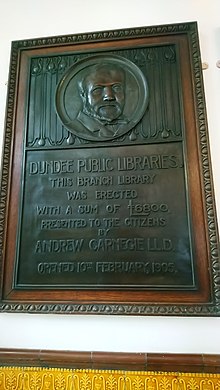List of Carnegie libraries in Europe
A Carnegie library was built in the 1920s for the University of Leuven to replace a building destroyed in the First World War.
Funding came from the Carnegie Endowment for International Peace, which also built libraries in the war-damaged cities of Rheims and Belgrade.
Reims was devastated in the First World War and the losses included library accommodation in the town-hall.
The Art Deco building was finished in 1927, and opened the following year in the presence of Gaston Doumergue, the French President and Myron T. Herrick, the US ambassador.
[65] Much of Belgrade was destroyed in the First World War, and in the 1920s it became one of three "front-line" cities to receive a Carnegie library, the other two being Leuven and Rheims.
In his retirement, Carnegie divided his time between the US and Scotland, and opened some British libraries personally.
[67]) In Stoke-on-Trent the Carnegie United Kingdom Trust funded a specialist ceramics library.
[68] The existence of special collections with catalogues gave scope for the development of interlibrary loans.
The trust continued to fund libraries after Carnegie's death in 1919, but its priorities shifted to other areas of its charitable work.
The drawings of the Carnegie libraries designed by architect James Robert Rhind are in the Strathclyde Archives, Glasgow.














